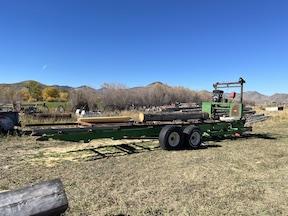
When Travis Carpenter picked up a homemade sawmill, he turned it over to the ranch manager and resident sawmill expert, Mark Oconnell. Oconnell is a former Vo-Ag instructor, who at one time purchased his own small Hudson sawmill. With it, he could provide students with lumber they couldn’t afford to buy.
“Mark is a phenomenal craftsman and keeps our place running with little downtime or incidents,” says Carpenter. “All I did was purchase the sawmill. It was his project and retrofit.”
Oconnell started with the sawmill. It had about 18 ft. of homemade track. The mill didn’t run, so his first task was to go through everything.
“I put a new carburetor on it, new bearings and new carrier bearings for the wheels to run on the tracks,” says Oconnell. “I also put an electric winch on it to raise and lower the blade.”
Carpenter had picked up a self-loading bale carrier at auction a few years earlier. When the sawmill arrived, Oconnell could see the two were made for each other.
“The carrier frame was perfect for the track,” he says.
Most of the work he did on the carrier was stripping away the extras, like the loading arm, pivot point, gears and chains, plus all the hydraulics.
“I thought I might be able to use the arm to pick up logs, but it was too far forward,” says Oconnell.
When the bale carrier had been stripped down to the frame, Oconnell set the tracks for the sawmill carriage in place. Although they were a hair wider than the bale carrier frame, the track cross members sat on the 2 by 6-in. carrier rails just fine. Where needed, he notched the carrier frame, so the track sat flat. When he put the sawmill carriage on the track, he leveled the track so he wouldn’t have to shim logs when milling.
“It was a perfect fit to marry the two together,” says Oconnell. “The bale carrier frame is solid. I’ve been around a lot of portable sawmills, and this is as stable as it can get. There’s virtually no setup when I pull it into the field to mill logs. I put down the tongue jack, unhook it from the tractor and go to work.”
Oconnell hung an old tank on the carriage for water to lubricate the blade. “It seemed to fit,” he says. “It has a nice brass valve to control water flow and a line to the saw blade.”
He also added about 7 ft. to the track, bringing it to about 25 ft. total. The length is also about right for his needs.
“I can mill out a 23-ft. footboard and then cut it up to hang between posts 10 ft. apart,” says Oconnell.
The actual throat is only 32 in., but there is 50 in. between the carriage uprights. He is confident he could mill a log 4 ft. in diameter, flipping it over and raising and lowering the saw blade as he cut it down to a 4-sided cant.
“I think I can mill just about any logs we might have here in Montana,” says Oconnell.
Contact: FARM SHOW Followup, Mark Oconnell, Dillon, Mont. 59725.
